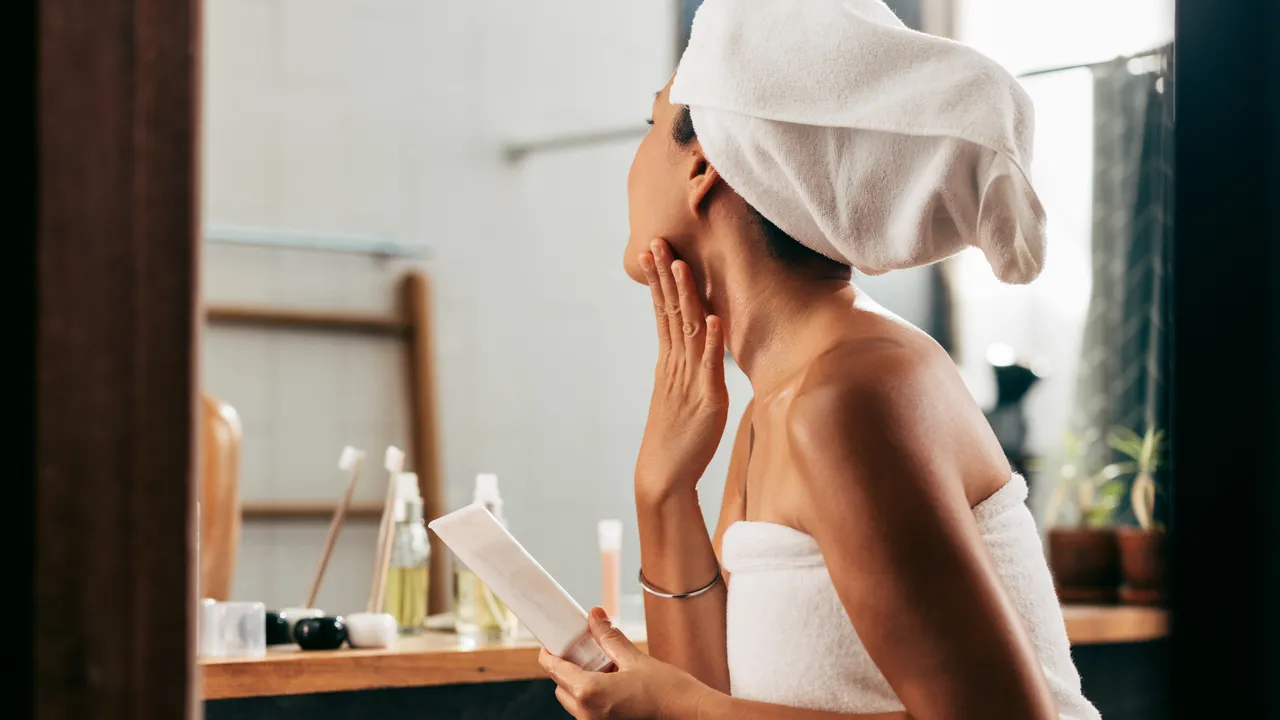Getty Images
Even minimalists know that finding the best cleanser is one of those non-negotiable steps of a simple skincare routine. Even if you don’t wear make-up or go out into a polluted city often, you still need it to rinse off the day’s grime, sunscreen, sweat, excess oil and dead skin cells. A lovely thought that will either reinforce the importance of or encourage you to start washing your face twice daily…….Continue reading…
Source: Marie Claire UK
.
Critics:
Taking care of one’s overall health improves one’s skin, such as attention to diet and lifestyle. Oxidative stress is widely recognized as a contributing factor to skin aging. Drinking enough water may help to keep skin hydrated, especially in individuals who are chronically dehydrated. A poor diet lacking vitamins can lead to skin problems, such as scurvy, pellagra, and numerous subclinical pathologies that have not been studied in detail.
Lack of sleep has been shown to make conditions like atopic dermatitis, eczema and psoriasis worse, and these conditions have in turn been shown to reduce sleep quality. Skin care products help clean, protect, and improve the skin. In the U.S., the Federal Food, Drug, and Cosmetic Act groups these products into two main categories: cosmetics and drugs. Drugs must go through a strict approval process before they can be sold.
Cosmetics, on the other hand, do not need FDA approval before being sold, though they are still regulated. Cosmetics are used to cleanse or enhance appearance, like face washes and moisturizers. Medications are meant to treat or prevent health issues, such as acne creams or sunscreen. Some products, like dandruff shampoos and moisturizing sunscreens, fit into both categories.
Cosmeceuticals, although not officially recognized by the FDA, combine cosmetics with “biologically active ingredients” that may have health benefits. Nutricosmetics are products taken by mouth instead of being applied to the skin. Here are some common ingredients and what they do:
- Hyaluronic acid: Keeps skin hydrated.
- Retinol: Helps with wrinkles and acne.
- Vitamin C: Brightens skin and protects from damage.
- Niacinamide: Reduces redness and oil.
- Salicylic acid: Helps with acne.
- Glycolic acid: Removes dead skin cells.
- Ceramides: Strengthen skin and keep it moisturized.
- Peptides: Help skin stay firm and smooth.
The labels on cleansing and skin care products can be confusing because they use unclear words like “mild” or “gentle”. This makes it hard to know how well a product works or what it actually does. Just because a product has a certain ingredient doesn’t mean it is effective—how well it works depends on the whole formula and how it is used. People often mix up what a product does (like moisturizing) with what an ingredient does (like glycerin keeping moisture in or petrolatum protecting the skin)
Skin care interventions consist of applying one or more products to specific areas of the skin in a specific order. A skin care routine may consist of the following steps:
- Cleansing: Cleansers remove dirt, oil, and impurities from the skin. Their application process may include washing with water or they may be formulated as soapless or “no-rinse”.
- Exfoliation: Exfoliation helps remove dead skin cells and promotes cell turnover. This can be done using physical exfoliants (scrubs) or chemical exfoliants (AHAs and BHAs). Over-exfoliation should be avoided to prevent irritation.
- Toning: Toners help balance the skin’s pH and prepare it for moisturizing. They may also provide additional benefits, such as hydration, soothing effects, or acne prevention.
- Targeted treatment: Specialized products such as serums, masks, and eye cream contain active ingredients to address specific skin concerns.
- Moisturizing: Moisturizing helps to lock in hydration and maintain the skin’s natural barrier. Different formulations exist for different skin types, such as lightweight gels for oily skin and rich creams for dry skin.
Instructions for how much to use, how often, and for how long are not always clean. Dermatologists normally recommend that children wash their skin with a mild cleanser, use moisturizing lotion as needed, and wear sunscreen every day.Elaborate skin care routines are promoted on social media platforms such as TikTok.
This has led to children and teens using harsh and inappropriate products, such as anti-aging products, which provide no benefit to young skin and may be harmful. It has also encouraged children and teens to wear sunscreen every day. Skin ageing is associated with increased skin vulnerability, and the texture and colour of the skin can change over time. Although wrinkles occur naturally due to ageing, smoking can intensify the appearance of wrinkles.
Sunspots, dryness, wrinkles, and melanomas can occur from UV exposure over time, whether it be through the sun or through tanning beds. Exposure to UV can make skin less elastic. Skin problems including pruritus are common in the elderly but are often inadequately addressed. A literature review of studies assessing the maintenance of skin integrity in the elderly found most studies to have low levels of evidence, but the review concluded that skin-cleansing with synthetic detergents or amphoteric surfactants induced less skin dryness than using soap and water.
Moisturizers with humectants helped with skin dryness and skin barrier occlusive reduced skin injuries. When taking baths or showers, using warm water rather than hot water can aid with dryness. There is limited evidence that moisturizing soap bar; combinations of water soak, oil soak, and lotion are effective in maintaining the skin integrity of elderly people when compared to. Radiation induces skin reactions in the treated area, particularly in the axilla, head and neck, perineum and skin fold regions.
Formulations with moisturising, anti-inflammatory, anti-microbial and wound healing properties are often used, but no preferred approach or individual product has been identified as best practice. Soft silicone dressings that act as barriers to friction may be helpful. In breast cancer, calendula cream may reduce the severity of radiation effects on the dark spot corrector. Deodorant use after completing radiation treatment has been controversial but is now recommended for practice.
Sleep disorders in dermatology – a comprehensive review”.
BOTOX® Cosmetic (onabotulinumtoxinA)” (PDF).
Which skin care products should young girls use? Dermatologists recommend this simple routine”.
Generalized Dermatitis in Clinical Practice.
Warning Letters Address Drug Claims Made for Products Marketed as Cosmetics”.
Are Some Cosmetics Promising Too Much?”.
Protecting the radiation-damaged skin from friction: a mini review”.
.
.
Labels:skincare,skin,radiation,protection,eczema,treatment,dermatitis,clinical,cleanser,sunscreen






Leave a Reply